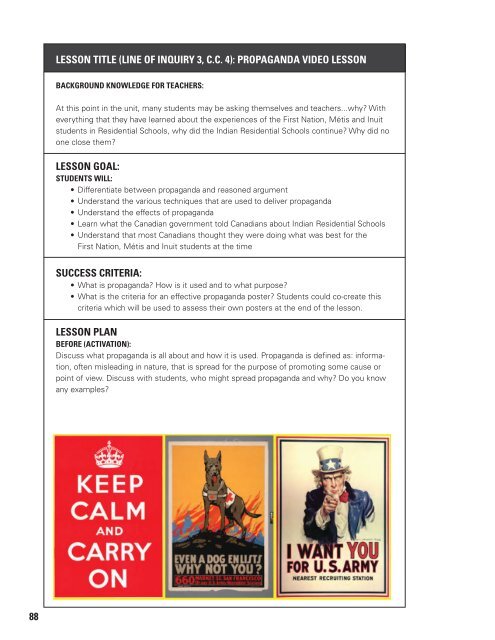Residential Residential
Residential_School
Residential_School
You also want an ePaper? Increase the reach of your titles
YUMPU automatically turns print PDFs into web optimized ePapers that Google loves.
LESSON TITLE (LINE OF INQUIRY 3, C.C. 4): PROPAGANDA VIDEO LESSON<br />
BACKGROUND KNOWLEDGE FOR TEACHERS:<br />
At this point in the unit, many students may be asking themselves and teachers...why? With<br />
everything that they have learned about the experiences of the First Nation, Métis and Inuit<br />
students in <strong>Residential</strong> Schools, why did the Indian <strong>Residential</strong> Schools continue? Why did no<br />
one close them?<br />
LESSON GOAL:<br />
STUDENTS WILL:<br />
• Differentiate between propaganda and reasoned argument<br />
• Understand the various techniques that are used to deliver propaganda<br />
• Understand the effects of propaganda<br />
• Learn what the Canadian government told Canadians about Indian <strong>Residential</strong> Schools<br />
• Understand that most Canadians thought they were doing what was best for the<br />
First Nation, Métis and Inuit students at the time<br />
SUCCESS CRITERIA:<br />
• What is propaganda? How is it used and to what purpose?<br />
• What is the criteria for an effective propaganda poster? Students could co-create this<br />
criteria which will be used to assess their own posters at the end of the lesson.<br />
LESSON PLAN<br />
BEFORE (ACTIVATION):<br />
Discuss what propaganda is all about and how it is used. Propaganda is defined as: information,<br />
often misleading in nature, that is spread for the purpose of promoting some cause or<br />
point of view. Discuss with students, who might spread propaganda and why? Do you know<br />
any examples?<br />
88


